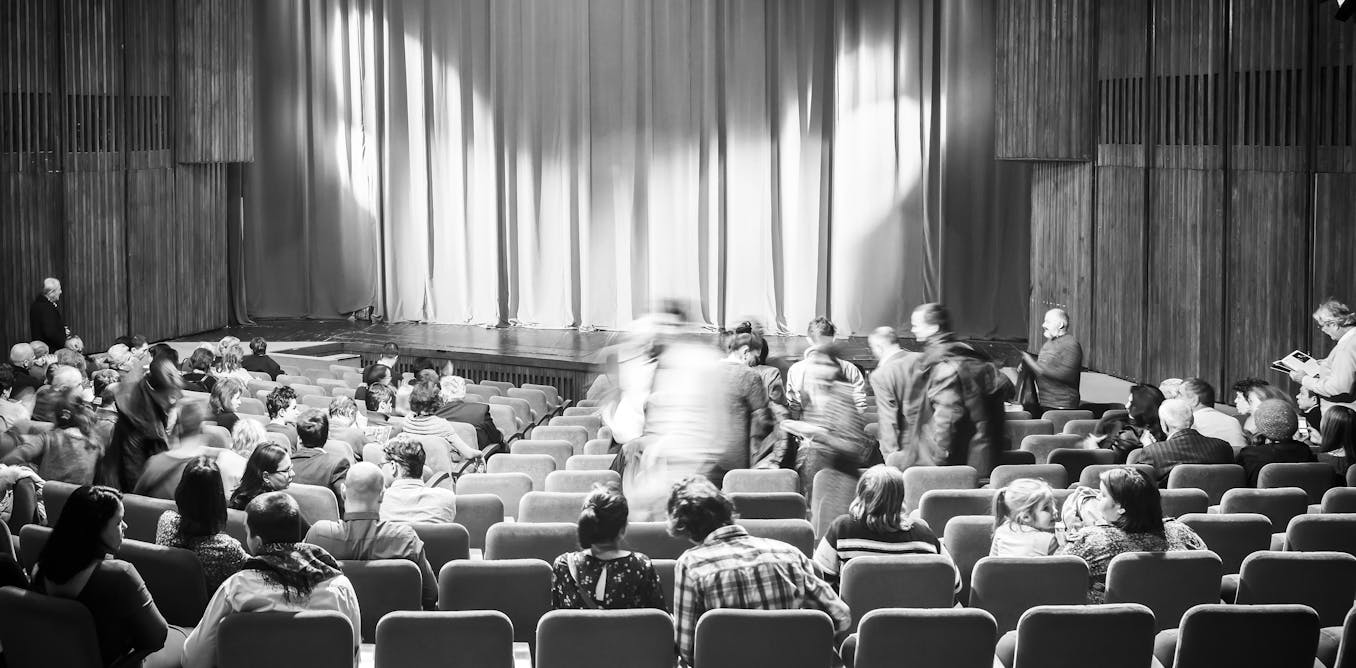Philosophy is the study of fundamental questions about reality, knowledge, and values. One “does philosophy” when they respond to such questions in ways that engage critical thought and inquiry.
Many of us will often respond philosophically to the world around us without even realising it. We may do this, for instance, when we reflect on various aspects of culture and the arts.
But does going to the cinema really amount to doing philosophy? While you may have never thought about it this way, this is exactly what one famous French philosopher named Gilles Deleuze (1925–95) argued.
Deleuze’s movement-image
Deleuze presents a philosophical approach to cinema that treats films not merely as entertainment, but as a medium for thinking and creating philosophical concepts.
This creation of philosophical concepts is what he and his collaborator, Felix Guattari, prize as “doing philosophy” in their 1991 book What is Philosophy?.
For Deleuze and Guattari, the creation of concepts is not entirely mental. It is an embodied process that involves engaging the senses – which is what cinema demands of both filmmakers and viewers. To that end, filmmakers and film viewers can both be seen as special kinds of philosophers.
Deleuze suggests cinema is not simply leisure or culture. In his 1983 book Cinema 1: The Movement-Image, he highlights how cinema is a philosophical practice made possible though “movement-images” – cinematic images which can actively shape our perception and experience of the world.
Great film directors can create concepts through movement-images, just as great philosophers do so through language.
Kumiko Shimizu/Unsplash
Deleuze identified three categories of movement-images: perception-images, affection-images and action-images.
The perception-image frames the world from a particular point of view, usually to establish context for an action. For example, at the start of a scene, the camera might pan across the contents of a room before resting on the protagonist.
The affection-image is the cinematic expression of pure emotion. Affection-images can evoke empathy, such as when we see a character’s face overcome with sadness in a close-up. These images usually sit between perception and action images.
The action-image embodies action and reaction within a defined situation, and usually links perception and affection images. In the horror genre, this may be the “jump scare” that suddenly reveals a killer, after a long buildup of tension.
Deleuze’s time-image
In his 1985 book Cinema 2: The Time-Image, Deleuze extends his film philosophy from that of movement-images to include time-images.
The time-image is one where the experience of time is prioritised over narrative. For instance, a time-image may make use of long takes, empty spaces and irrational cuts to depict time directly onscreen, rather than represent time through props.
Through masterfully crafting movement-images and time-images, directors can (knowingly or unwittingly) create the opportunity for audiences to think about philosophical concepts and themes.
For example, in the trailer for Get Out (2017), director Jordan Peele uses a range of movement-images and time-images to convey the concepts of racism, trauma, social isolation and social stratification.
Multiple closeups of main character Chris Washington’s face looking alarmed produce affection-images (a type of movement-image) that engage the viewer’s emotions.
Peele also strategically uses time-images to intensify the themes being conveyed, such as when Rose’s mother clinks the spoon on the teacup, both moving Chris back in time and freezing him in real time.
For Deleuze, it is these embodied, affective experiences that are the fundamental conditions for thought. By allowing the film to be sensed and felt, and by transmuting these feelings into the domain of thought, the cinemagoer can become philosophically engaged.
Repetition is another element that can bear philosophical fruits, according to Deleuze. The more one repeats a film, whether by re-watching, or repeating certain sequences, the more they allow themselves to be affected by it in different ways. This opens up different avenues for thought.
How to engage philosophically with films
Cinemagoers need not be familiar with Deleuze’s ideas to engage philosophically with a film. The only thing required is an openness to the film. But if you do want to consciously approach your next viewing like a philosopher, you might consider the following steps:
-
Feel as you watch. Open yourself up and allow cinematic moments to affect you on an emotional and bodily level, even if this is unpleasant or uncomfortable.
-
Allow for multiple interpretations. Resist the temptation to fall into black and white thinking about which characters are “good” or “bad”. Remain open to different readings of the film.
-
Reflect on what you felt. Allow what you experienced in your body guide your thoughts afterwards. For instance, if you experienced shock, rage, or confusion, ask yourself why.
-
Gently arrive at some conclusions based on your multiple readings of the film. Allow for perspectives that both contribute to and challenge your worldview.
-
Consider watching the film again, and repeating the above steps. This will likely help you feel and think new things that further enhance your understanding of the film, and your worldview.

The post “How to approach going to the cinema like a philosopher” by Alain Guillemain, PhD Candidate in Philosophy, Deakin University was published on 07/15/2025 by theconversation.com



































Leave a Reply